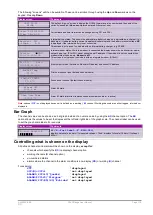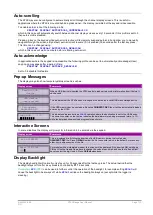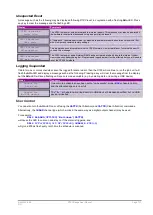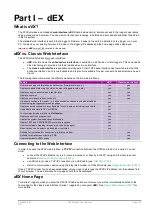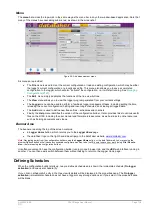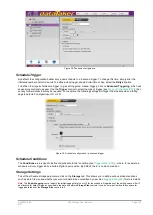
UM-0085-B09
DT80 Range User Manual
Page 116
RG
To safely remove a USB device, you should always first issue the
REMOVEMEDIA
command. This command is also one
of the default options on the front panel function menu
. This command will:
1.
suspend logging for any schedules that are configured to log directly to the USB memory device. This will cause
an error message to be returned, and the
Attn
LED will start flashing
2.
make sure that all required information has been fully copied to the device and all files are closed
3.
shut down the device. If the device has an indicator light, it should now be off
If you change your mind and want to keep using the device, you will now need to remove it and then re-insert it.
File Commands
The
DT80
provides a number of general purpose file manipulation commands. These will work both for files stored on the
internal file system (
B:
) and an external USB memory device (
A:
), if one is present.
Command
Function
COPY
source
dest
reads the file
source
and creates a copy called
dest
. If
dest
is a folder name (i.e it ends
with a
\
character) then a file will be created with the same name as the source.
COPY
source
ftp-URI
uploads the file
source
to the FTP server pathname specified by
ftp-URI
COPY
ftp-URI
dest
downloads the FTP server file
ftp-URI
and writes it to local file
dest
RENAME
source
dest
rename file path
source
to file path
dest
RENAME
ftp-URI
destfile
rename FTP server file path
ftp-URI
to file name
destfile
DIR
path
lists the contents of directory
path
. If
path
is not specified,
B:\
is assumed.
DIR
ftp-URI
list contents of FTP server folder path
ftp-URI
DIRTREE
path
lists the contents of directory
path
and all sub-directories. If
path
is not specified,
B:\
is assumed.
TYPE
source
displays the contents of file
source
. Use only with text files.
DEL
source
deletes the file
source
. Use with care!
DELTREE
path
deletes the directory
path
and all subdirectories. Use with care!
FORMAT A:
deletes all files from the USB memory device and re-creates the file system. Use with
care! For best performance, it is recommended that new USB devices be formatted in
the
DT80
before use.
FORMAT B: DELETEALL
deletes all files from the internal flash drive and re-creates the file system. This
command would normally only ever be used if the
DT80
's internal compact flash card
was replaced. After executing this command it will be necessary to repeat the firmware
upgrade process in order to re-install system files (e.g. for the web interface) onto the
internal flash drive.
Note:
These commands are for advanced users only. In most cases the standard
DT80
commands (e.g.
LISTD
,
DELD
and so on)
are preferred. Furthermore, note that file names or locations may be subject to change in future firmware versions.
wildcards
(e.g.
"*.LOG"
) are not supported by any of these commands.
The
DT80
's default directory is
B:\
. So the command
DIR JOBS
is equivalent to
DIR B:\JOBS
.
For example, if you want to copy the
DT80
's system event log to a USB memory device for later analysis you could use:
COPY EVENTS\EVENT.LOG A:\EVENT_20060219.LOG
Done
Important:
The
DeTransfer
program, which is often used to supervise the
DT80
, has a number of special commands that begin with a
\
(backslash) character. These are interpreted by
DeTransfer
and not sent to the
DT80
. In order to send a
\
character from
DeTransfer
, you need to enter a double backslash (
\\
). For example, the above example would be entered into
DeTransfer
as follows:
COPY EVENTS\\EVENT.LOG A:\\EVENT_20060219.LOG
This rule applies to
DeTransfer
only; it does not apply to the "Text" window in
DeLogger
, nor to the web interface Command window.
Data Recovery
Prevention
If you accidentally remove a USB device while it is being accessed, then it is possible that the file system on the USB
device may be corrupted. (The same applies if you remove a USB memory device from a Windows computer without
selecting the "Safely Remove Hardware" option.)
The internal file system or USB memory device may also be corrupted if the logger suddenly loses all power while it is
writing to the disk.
To minimise the chance of data loss due to these causes, remember to:
•
ensure that the battery link is in place. This will allow the
DT80
to keep operating normally for a period of time,
in the event of an external power failure


















